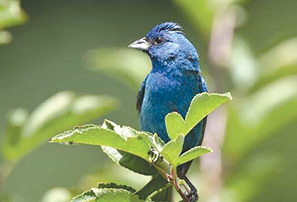This is how the repartee unfolds as we get ready to hit the trails each week. There is a flurry of text messages, emails, and phone calls regarding all the wonderful places in town to stretch our legs. Ouija boards, spinners and rounds of rock, paper, scissors all become important tools in our decision making. It starts as a polite exchange, until I hijack the suggestions and begin to push my own recommendation with great gusto. The give and take builds to a crescendo when I pitch which piece of open space will best meet our needs (aka where I want to go). By the grace of God my groupmates are incredibly compliant, and with a minimum of eye rolling we find ourselves strapping on our boots in some parking lot and heading off. Somedays we are looking to climb hills, some days we want to be near a body of water, and some days we have our sights set on a certain species we want to see. More often than not this summer, our eyes were on the beautiful indigo bunting. So our hikes took us to a sunny portion of the Metacomet Trail which was nicknamed Bunting Boulevard by one of the hikers, and we could count on hearing and seeing the buntings each time we reached the trail where it met the power lines. Buntings like that kind of edgy terrain in shrubby areas near fields and woods. Sensing all eyes on him, the bunting himself was very agreeable, displaying his amazing blue plumage and singing and singing. Once we had heard him call for an hour or two, we fanned out and began to notice other buntings calling on the rail trail, behind Spaulding School, at Hilltop Farm, and in the tobacco fields.
By this time of year, the bunting is mostly quiet. He has hooked up with a female bunting whose coloration is more subtle to camouflage her on the nest. They have raised a brood or two, dined on seeds and insects, and are contemplating their pilgrimage to Central America as the days get shorter. Like many songbirds, these buntings have quite the trip ahead, and migration is no simple feat. Indigo buntings travel at night and are guided by the stars. They can adjust the angle of their flight to that of certain celestial points, their favorite being Polaris. So while you and I have our heads on our pillows, these diminutive songbirds are madly flapping their way thousands of miles in the pitch black to the tropics. For some reason I cannot get their impending trip out of my head and find myself studying the constellations at night, wondering about their trip and feeling small. With my stream of consciousness fully activated, I got to thinking about voyages under the cover of darkness. I thought about folks on the Mayflower who embarked on a life changing trip around this time of year, guided by stars and a feeling of hope. They, like the buntings, knew what the darkness of night was all about and had the courage to keep moving forward. And it’s not just those traditional pilgrims in their buckle shoes and scratchy wool from centuries ago. Some people today are on the move, under less than ideal circumstances and despite the odds, they push through the darkness.
So, with new eyes I say goodbye to my bunting friends and hope by the time the cold weather arrives that they have touched down safely. I’ve already got my daydream of them going full force. For edginess, they have traded the power lines for some clearing by a cave system in Belize flanked by some Mayan ruins. I think the bunting would look splendid against that backdrop. I wish I had a trip booked to check on him in the winter months. Believe me, I’ll be counting the days until he returns.
